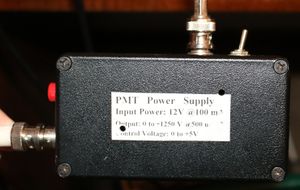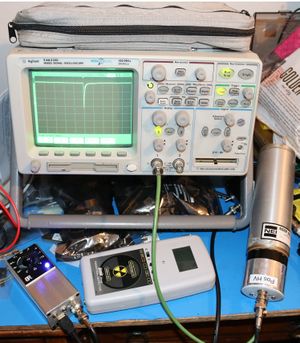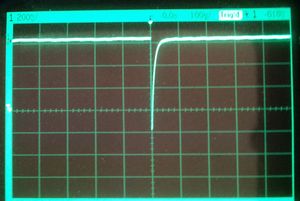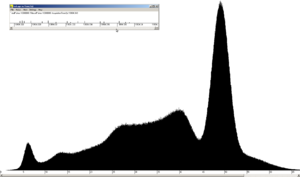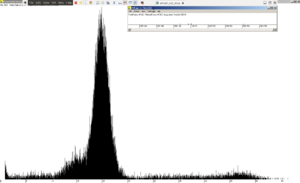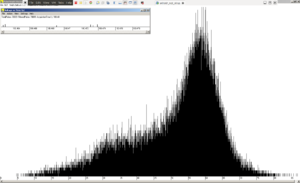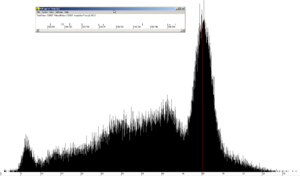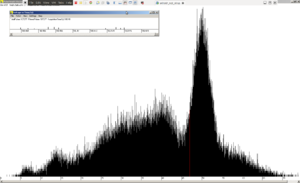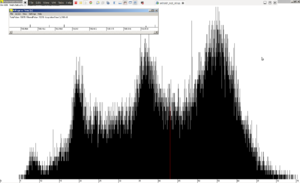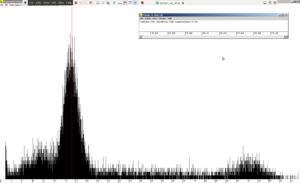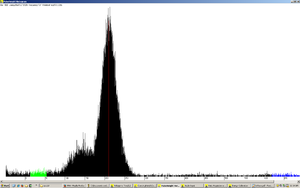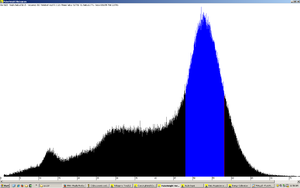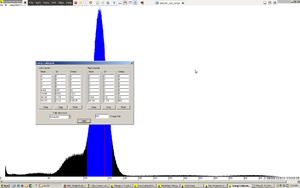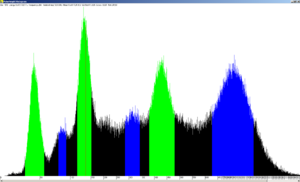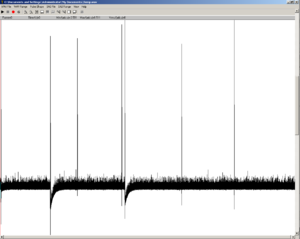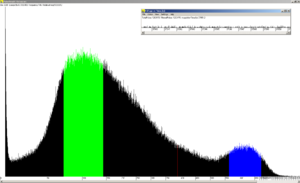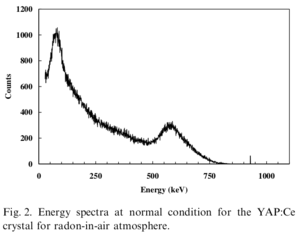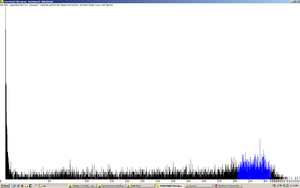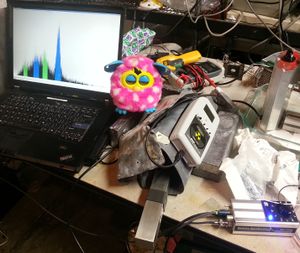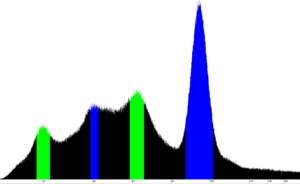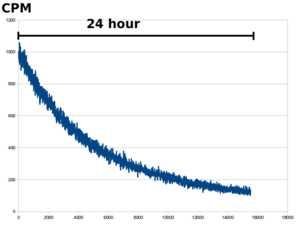User:Mcmaster/Gamma Spectroscopy
Notes trying to get a gamma spectrometer working. No real goal, just educational
Contents
Gamma Spectacular evaluation
This is for people trying to figure out if they want a GS and for Bee Research on suggestions on how to improve
Overall evaluation: if you don't know anything about gamma spectroscopy this is a good place to start. Its relatively low cost and comes with quick start documentation. The documentation could use some polishing but I was able to figure it out without too much trouble.
For my evaluation I used:
- GS: GS-1100A
- NaI(Tl) probe: SAINT-GOBAIN 1600-2265
- PRA: 10.2.23
- Manual: GS-1100A for PRA 8.0
GS itself
- Price is relatively high given the very simple electronics. However, it does take a lot of work to ship a product and write/support the software. Not sure what the volume of these are, but probably reasonably low which makes NRE passed onto consumer higher
- Below may not be true: still having problems on external power supply. Suspect faulty tube circuitry
- Was not able to provide enough current to reliably drive my two coax PMT. While this is a larger tube than normal, I believe its not abnormal for two coax tubes which my GS model is supposed to support
- BNC/SHV connection woes. I would pay extra for there to be a BNC and SHV on the HV connector. I might open up my case and add one.
Manual:
- Tell users to do things instead of suggesting them: advanced users know what they are doing and will do what they want to. For example: ROI section should tell you to use ROI and walk you through it instead of only saying you could use the ROI feature. Think this stems from trying to dual purpose as a quick start and a reference guide
- I have an old manual for the software version. While the PRA manual is built into the software, I could not find an updated GS manual published
- "choo-choo 1 2 3": ??? Apparently a Disney TV show reference
- Height calibration / InTune
- InTune: needs some better explanation of how to navigate. When I recorded for a bit it was a black screen and got confused. I had to poke around a bit to figure out what was going on
- InTune: need to talk about effect of pulse rate and not just height (ex: long enough between pulses to observe noise floor)
- InTune section: doesn't tell you to get noise floor (which you'll need later). I had closed InTune and had to recapture data
- InTune: showing how to get ROIs would make this easier to get better min/max
- "The optimum volume for PRA spectrometry is when the most energetic pulses are between 40 and 60 arbitrary units". Why?
- Despite this, the diagram shows 66 au
- Later it says that if you are using Cs you should do 25% instead. This further adds to my confusion
- Whats with min/max au? They are always the same value
- Pulse height histogram example: use Cs-137. It will give people a more warm fuzzy that they are getting good results since they should be using Cs-137
- ROI is required and non-intuitive. You must walk the user through how to do this
- Tell the user to do ROI when they are looking at the peaks. They have to backtrack and figure this out by themselves
- Pulse shape acquisition: need explanation of why this helps. Detector imperfections? Pulse pileup?
- Recording first pulse height spectrum: use energy calibration is checked in manual (as well as subsequent diagram). This is confusing since users were instructed to use au
- Several pages have sentences that don't continue on the next page (9, 10)
- Fit calibration mode: GUI default is Fit Slope but manual image says Fit linear. Was I supposed to change this? If not make the manual match the defaults
PRA:
- I tried a few different ROI's for getting u/SD for calibration. It would be great if there was some way to make the process more repeatable/automated
- Some important elements of the GUI are non-intuitive (ex: ROI)
- Pulse recognition threshold seems to have changed from fraction to percent. However, neither GUI indicates units
- Since Cs-137 calibration is such a common thing, a super streamlined wizard would be nice
Misc:
- St Gobain detector has non-linear frequency response. Took 4 peaks to get any reasonable calibration to measure the Eu-152
- Detector selection: the official Bee Research probes are $900-1400. With the Saint-Gobain 1600-2265 on the surplus market for under $100, its tempting to recommend it but need to understand the non-linearity better. Does an official detector have this same problem?
- Original issues were caused by a bad audio cable. I believe this was the cable that came with the GS but I can't say for certain
- I used under Linux through VMWare without issue. I have not tried under WINE
- A concise quick start video would be nice. I looked briefly and found some people that did 1 hour (!) videos that I wasn't going to watch
Isotope inventory
Higher activity (order 10 uC estimated):
- Cd-109
- Th(CO3)2
- U (misc samples)
Low acitvity:
- Pb-210 (cloud chamber kit)
- Ra-226 (SD)
- Am-241 (SD)
Misc:
- Misc U glass from vacuum tubes, etc
- Co-60 spark gap: very old, not detectable
- Spark gap. I think this is Cs-137 but would have to check
Equipment inventory
Include:
- Gamma Spectacular GS-1100A
- Nuclear Enterprises, Inc. Na(Tl) scintillator-PMT assembly w/ base
- TYPE: ?
- SERIAL: 3300
- CRYSTAL BY HORIBA
- Several PGT assemblies
- Require LN2
- Misc issues
- Don't want to use these initially
- Harshaw Pre-amp
- Ortec 456 NIM HV supply
- SHV to BNC converter (gutted PMT supply)
2015-08-03 test
Hooked up PMT assembly to GS but couldn't get any usable readings. As I turn the GS voltage knob I can hear audio crackle and the frequency output changes slightly
Found that 800V dial 740V actual. Tried cranking up a little to see if that made a difference.
Still using the GS to power the PMT assembly, I removed the signal cable from the GS and instead fed that output into my scope. Yipee! I get some pulses
Unfortunately, the pulses don't seem to be correlated to radiation levels. That is, I tried putting some sources (Am-210, U, Th) near it and pulses seem to come in at about the same (random) rate.
Next steps:
- Understand isotope expected spectrum better
- Is the Al case blocking expected signals?
- Light leak?
- I tried wrapping it in a towel and no improvement
- Ask around about pulses
- Is GS providing enough power? This is a large PMT
- Try other HV supplies
- Tried the NIM supply. Same result
- How much does PMT take?
- How much does GS deliver?
- Try other HV supplies
- At ~700V the pulses become much sparser
- Think about the same at 900V
- No pulses with power removed completely
- Sometimes several pulses of approximately the same height occur within a second
2015-08-04
TODO: add scope shots
Magically started working while sitting on the desk. Lightly sanded PMT contacts and hasn't had problems since
Also noted that while both the Ortec and the GS seem to be able to reach required voltage levels, it runs much better on the Ortec supply. I'm guessing thta the GS simply can't supply enough power. Will look into this more
Tests also show that some of the long cables I have right are causing unnecessary interference. I need to get some shorter cables.
Scope shots may show that the GS supplier is much nosier than the Ortec. Need to collect better data to verify this but it looks like GS may be switch mode and Ortec is linear
The U and Th sources seem to have a bunch of different energy levels. I'd like to start with something simpler like Cs-137. I have an old Cs-137 spark gap but I don't know enough about it to trust it as a calibration standard.
Looked into acquiring a Cs-137 check source. Looked at three suppliers:
- United Nuclear: 10 uC for $145 ($165.95 including S/H)
- Atlantic Nuclear: 10 uC for $135 + S/H
- Images, SI: 10 uC for $125 + S/H (IIRC about 145 total)
- From Spectrum Techniques
Originally I placed with United Nuclear but some combination of the lag on the order actually going through (PayPal is not actually integrated into their order flow) and the lower price I ordered with Images, SI instead
2015-08-13
Back from business trip
Got Cs-137 check source in mail
2015-08-14
Got SAINT-GOBAIN 1600-2265 in mail
Has a single signal/voltage port. Need to better understand dual vs single BNC topologies
Gamma Spectacular is stereo jack with one half connected
Running 1600-2265 at 900V. Responds to Cs-137
Can't get audio to record. Tried:
- t61p (ubuntu 12.04)
- t61p (windows)
- desktop (ubuntu 14.04)
- cnc laptop (ubuntu 12.04)
Earlier I had some limited success using the large tube but got only very week audio signals (were they maybe the built in mic?)
2015-08-15
Borrowed W520 (windows) and was able to easily record spectra. Indicates the GS does in fact work and I just need to solve my recording problems
2015-09-08
Issues were caused by bad audio cable. Replaced
Borrowed some isotopes for testing to augment what I have. Net list:
| Sample | uCi (orig) | Date | Half life | uCi (2015-09) |
% remain (2015-09) |
Source | |
|---|---|---|---|---|---|---|---|
| Am-241 | 1? | Smoke detector | |||||
| Cd-109 | 10,000 | ~10 uC | XRF gun | ||||
| Cd-109 | 10,000 | ~10 uC | XRF gun | ||||
| Cs-137 | 1 | Spectrum Tech (BK) | |||||
| Cs-137 | 10 | Spectrum Tech (JM) | |||||
| Cs-137 | ? | Spark gap | |||||
| Co-57 | 1 | Spectrum Tech (BK) | |||||
| Co-60 | 1 | Spectrum Tech (BK) | |||||
| Co-60 | ? | Spark gap | |||||
| Eu-152 | 1 | Spectrum Tech (BK) | |||||
| Pb-210 | ? | Cloud chamber | |||||
| Ra-226 | 0.5? | Smoke detector | |||||
| Th | ? | JJ minerals | |||||
| Tl-204 | 1 | Spectrum Tech (BK) | |||||
| U | ? | JJ minerals | YC | ||||
| U | ? | eBay | Autunite | ||||
| U | ? | Vacuum tube |
- branch? hmm unsure how to read this
- aha: its % of time that that gamma is emitted per decay
- note that gamma may not always be emitted or several may be emitted => does not necessarily add to 100%
2015-09-09
Cs-137 overnight
Above: 2 major peaks and 3 minor peaks visible
Idea was that this was going to serve as the master spectrum for calibration and so wanted to get it as accurate as possible. Unfortunately things have proven to be somewhat non-linear
Quick spectra
Each collected for 3 minutes. AU / no energy correction
Co-57
Co-60
Cs-137
Above: sample 1 (1 uC, older)
Above: sample 2 (10 uC, newer)
Eu-152
Tl-204
Tl-204 is not a gamma emitter yet there is one major peak and two smaller peaks. Is this background? Beta sensitivity?
Early measurements
I started trying to use the Cs-137 spectra for calibration (two peaks).
This gave the Co-57 peak around 210 keV when it should be around 125.
Co-60 should have been around 1250 but was far off (above has AU, I didn't record what the keV was).
I let the Co-60 settle for a bit and then took a more accurate Co-57 (above) to produce the calibration table above. Because my calibration is non-linear it must be set to interpolate mode.
Eu-152 detailed evaluation
Following above Eu-152 (my last gamma emitter) was evaluated to see how the calibration applied. It has a number of peaks which is good in that it gives me more to test against but is bad in that if things go awry it will be difficult to match expected vs actual peaks.
Once again, I'm using the Spectrum Techniques (ST) table as source of truth. For peaks that are close together, I measure against a weighted average. Note that only gammas that occur at least 3% of the time are included in these calculations
| Meas keV | Meas keV range | ST keV | ST % | ST weighted keV | % error | |
|---|---|---|---|---|---|---|
| 41.2 | 27.7 - 57.1 | 39.5 40 45 |
16 30 9 |
40.7 | 1.23 | |
| 86.7 | 81.1 - 93.1 | What is this? | ||||
| 125 | 111 - 154 | 121 | 28.4 | 121 | 3.31 | Cal at 122 keV means this isn't a shifted 244 |
| N/A | N/A | 244.7 |
7.6 | 244.7 | N/A | Why didn't this show up? |
| 314 | 287 - 343 | 344.3 | 26.5 | 344.3 | 9.65 | |
| 429 | 381 - 480 | 411.1 443.9 |
2.2 2.8 |
429 | 0.00 | Oh snap! |
| 1084 | 628 - 1750 | 778.9 964 1085.8 1112 1407.9 |
12.7 14.4 10 13.3 20.7 |
1105 | 1.93 |
A slightly longer running test shows that there might be a peak around 205
I expected higher energies inaccurate and lower energies accurate but its actually the inverse.
Next steps:
- try my other, larger tube and see what curves it produces
- Background (unshielded)
- Background (lead shileding)
Big tube
Not getting a clean signal. I had problems with this tube when I first got it not producing signals at all due to dirty contacts or something. Think this needs an overhaul before it can be trusted.
The tube portion is epoxied shut and is probably okay. The base was custom built by an individual (not familiar with their workmanship). Needs to be opened to examine solder joints, review schematic, etc.
2015-09-10
Background: unshielded
Above: my reading. Peaks at roughly 99.3 keV and 621 keV. The right peak looks like it might be several peaks...going to let it sit for a while longer to see what longer integration reveals. 1,280,000 counts in 37,500 sec => 34.1 CPS => 2048 CPM
Above (source): radon spectra. Peaks roughly at 75 keV and 575 keV. Not a perfect match, but seems reasonable given possible calibration errors on both sides
Background: shielded
Over about an hour (TODO: add detailed count information) in a lead castle. The immediate takeaway is that one of the peaks in the unshielded background is clearly visible while the other is gone. CPM has gone down dramatically to around 2 CPS => 120 CPM => 5.9% of unshielded level
2015-09-23
Used proton beam / cyclotron at UC Davis to test some PCBs. Ran some measurements on the lingering radiation for kicks
Above: test setup. One geiger counter is inside the lead shield (not visible) and another is outside.
Above: gamma spectrum using Gamma Spectacular w/ Saint Gobain sensor
Above: half life is about 8 hours from internal MyGeiger2
